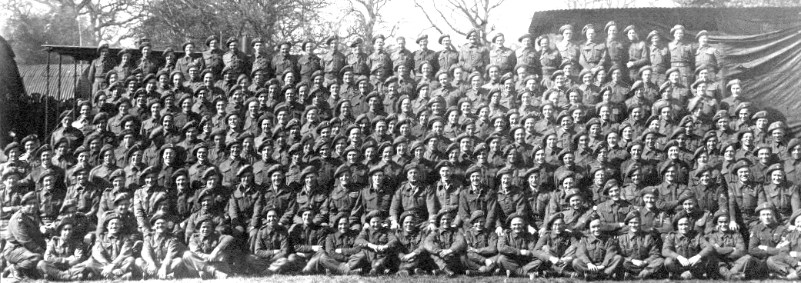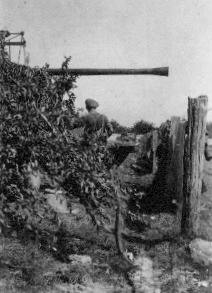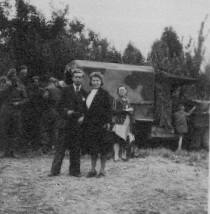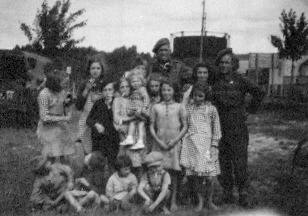The Coleraine


1939 - 1945
Introduction On June 6th 1944, three million personnel from the Allied Armies took part in the largest seaborne invasion in human history. In October 1945, five months after the war ended, demob started for the Battery.


6th Light Anti -Aircraft
Ipswich This Battery photograph was
taken in
"While we were at

It was at this stage of the war we were
issued with our berets for the first time. Until then we had worn the Glengarry.
The badge on the beret was the flaming bomb, as worn on our lapels. We never got
to wear the Royal Artillery badge on our berets. We were all Militia Volunteers.
It was only regular Army personnel posted into the

We were also issued with the shoulder flashes of the 30 Corps, the leaping Black Boar on a white background. Jim McCaw said, "Take my jacket down to the town and have one of the Welfare Women sew on the shoulder flashes for me". Willie Maxwell had a Biro pen, one of the first I ever saw in my life. It was a red Biro and he put a red tip on the boar's penis. Jim McCaw never saw the difference between his flashes and ours until someone said, "Jim, where did you get those flashes? We never got ones where the boar had a hard on". Robin Martin (2004)


The Battery Tac Sign and the Liberation Forces Star Combined
"The emblem of the Liberation Forces was the white star. All vehicles involved in the Normandy Landings had this stencilled on the side and top of the vehicles for easy recognition. The Battery added the shamrock to all their vehicles. There was one other innovation with the paint brush. When we were preparing for the move to Europe, Ernie Piney painted a name on each gun. Some little old ladies took offence to the name of our gun, 'The Impatient Virgin' and Capt Pelham ordered us to obliterate it". Spanky McGowan (2004)

|
Drive Past of the new issue Self Propelled Bofors (SP's) at Brook Hall Camp, Orwell Park, Ipswich 1944 Maj. DJ Christie Officer Commanding 6 LAA Bty, is the right hand officer. This photo was found in The Long Commons car park , Coleraine in 2000. Where is the remainder of this set??? |
The Battery left Tilbury Docks, Southampton on
board ss "John Souter" Doherty (1988) and headed for a spot between
the secured Juno and Gold beachheads. The disembarkation took place at Le
Hamel, east of Arramanches on the Normandy coast. Here, the Battery
relieved 113th
"The weather at this time was terrible, always raining. We had not washed for over two weeks. One day the Battery was cammed up in the corner of an orchard. Ernie Piney and myself had a great shower. We stripped off to the pelt and then put our boots on. We ran round the orchard a couple of times. I can still feel the fresh rain hitting my skin after all this time.
"The Bofors Guns were used in a ground role all the way through France until we reached the Nijmegan bridge. As part of the ground role we were asked on occasions to provide indicating fire for the Typhoons with the Bofors gun. On these occasions we fired three rounds of tracer on a designated bearing." Spanky McGowan (2004)
Montgomery's strategy at
Caen was misunderstood by the press, Eisenhower and the Germans. He did not plan
for a quick victory. Quite the reverse, he was engaged in a protracted battle.
Montgomery succeeded in drawing in all the German reserves to the Caen area. He
wanted them to commit themselves to the defence of Caen. In doing so, the
Germans had depleted their forces in the West. This allowed the American Army to
capture and control the west coast ports of Cherborg and Cotentin.
At
"Bob Balmer called
the tanks sardine tins. The
"We were in visual contact with Caen during the Counter Mortar role. All the orders we ever got were, "No 1 gun one round fire!" "No 2 gun one round fire!". Whoever was in the observation post was doing a great job because all the guns were never needed to hit a single target. For a whole day we were picking off individual targets.
This was near the end of the war and the hedges were all over 4 meters high. During the German occupation no one was available or interested in keeping the hedgerows tidy." Robin Martin (2004)

SP Bofors in their Ground Role
Caen had been surrounded and attacked on three different occasions between June 7th and July 1st 1944. On July 7th it was surrounded again and Montgomery mounted another final attack. As well as the Land Artillery, this final assault involved over 500 heavy bombers and Royal Naval gun fire from HMS Rodney, HMS Belfast and HMS Roberts. Caen was in Allied hands by July 8th. The fall of Caen allowed the Allied Armies to break out of the Normandy beachhead and start the advance towards Germany.
It was at this stage
of the war a major reorganisation of all Allied AA units took place. The Allies
had gained air supremacy in
"I stayed with the Battery until Caen fell on the 8/9 July 1944. The Royal Artillery AA Batteries were reorganised in that they lost over 30 men each to infantry regiments. After the bombing raid that finished Caen we were all in the troop HQ for breakfast. I heard a dull thud and saw steam coming out of the banking behind me. It was a 3" AP shell steaming in the wet ground. I left it there and finished my breakfast. After the meal I was detailed along with some other gunners to leave the battery for good.
Normandy was bursting at the seams. The troops were all moving inland and we had trouble getting onto the Mulberry Harbour to return us to England." Robin Martin (2004)
"The Germans were on the run and what a welcome we got from the men, women and children. They all stood by the roadside throwing apples into our vehicles. You see it was the apple harvest time. We had a splendid air force that took a lot of work off our hands. The Germans were thoroughly beaten. We met crowds of them walking along the road with their hands up." Sam Nevin (2004)
The Falaise Gap After
"When we broke out of the bridgehead at
Somehow or other I remember sitting in the SP with Markus Wilton driving. Now, Marcus was a sensitive soul from Portstewart. He wrote home to his wife Jean every day. He always got a letter from her at every mail drop. When we hit a bump in the road I said to Marcus, "F*** me Marcus, you just went over that Germans head". Marcus nearly lost control of the SP. But, you could not miss running over bodies, the road was blocked solid." anon (2004)
After the Falaise Gap, the
Battery moved on to Argentan,
Belgium

Tournay near Brussels. A French couple engaged to be married.

Louvaine